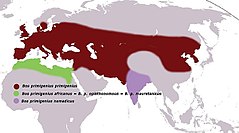Bos primigenius
| Aurochs Temporal range: From early to 1627 (wild form) resp. Present (domestic form) |
|
|---|---|
 |
|
| Mounted skeleton in National Museum of Denmark in Copenhagen | |
| Scientific classification | |
| Kingdom: | Animalia |
| Phylum: | Chordata |
| Class: | Mammalia |
| Order: | Artiodactyla |
| Family: | Bovidae |
| Subfamily: | Bovinae |
| Genus: | Bos |
| Species: | †B. primigenius |
| Binomial name | |
|
Bos primigenius (Bojanus, 1827) |
|
| Subspecies | |
|
Wild:
domestic:
|
|
 |
|
| Distribution of the three subspecies | |
| Synonyms | |
|
List
|
|
Wild:
domestic:
The aurochs (/ˈɔːrɒks/ or /ˈaʊrɒks/; pl. aurochs, or rarely aurochsen, aurochses), also urus, ure (Bos primigenius), is an extinct type of large wild cattle that inhabited Europe, Asia, and North Africa. It is the ancestor of domestic cattle. The species survived in Europe until the last recorded aurochs died in the Jaktorów Forest, Poland in 1627.
During the Neolithic Revolution, which occurred during the early Holocene, at least two aurochs domestication events occurred: one related to the Indian subspecies, leading to zebu cattle, and the other one related to the Eurasian subspecies, leading to taurine cattle. Other species of wild bovines were also domesticated, namely the wild water buffalo, gaur, and banteng. In modern cattle, numerous breeds share characteristics of the aurochs, such as a dark colour in the bulls with a light eel stripe along the back (the cows being lighter), or a typical aurochs-like horn shape.
The aurochs was variously classified as Bos primigenius, Bos taurus, or, in old sources, Bos urus. However, in 2003, the International Commission on Zoological Nomenclature "conserved the usage of 17 specific names based on wild species, which are predated by or contemporary with those based on domestic forms", confirming Bos primigenius for the aurochs. Taxonomists who consider domesticated cattle a subspecies of the wild aurochs should use B. primigenius taurus; those who consider domesticated cattle to be a separate species may use the name B. taurus, which the Commission has kept available for that purpose.
...
Wikipedia

